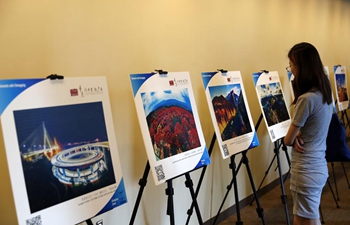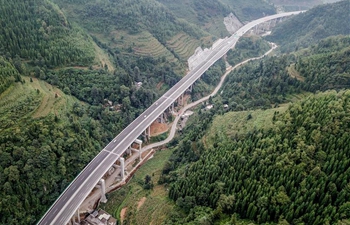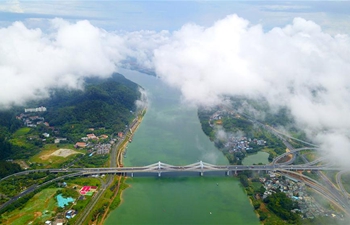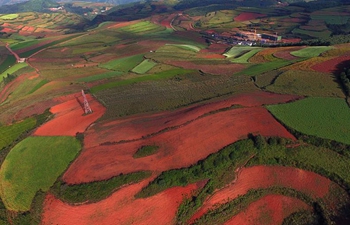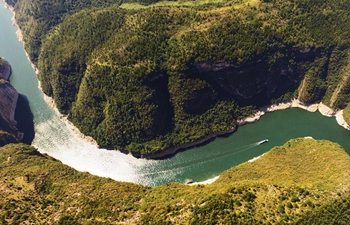By Xinhua writer Zhang Yiyi
GUIYANG, Sept. 1 (Xinhua) -- Perched atop a cliff over 100 meters above the ground, a gallery with glass facades "floats" over a lush canyon in southwest China's Bouyei-Miao Autonomous Prefecture of Qianxinan, Guizhou Province, gaining a lot of attention from both home and abroad.
The Limestone Gallery has recently been named among the July Winners of "the Architizer A+Awards", also known as "the architecture Oscars." This year, more than 5,000 entries from over 100 nations competed for the U.S. awards.
Located to the north of the Haiwei Canyon of Dushan Township in Qianxinan's Anlong County, the gallery sits in a natural indentation on top of the 165-meter-high cliff, as if completing a missing part of the mountaintop.
"Two key motifs throughout the design are 'to hide' and 'to borrow,'" He Wei, designer of the gallery and associate professor at the Central Academy of Fine Arts, told Xinhua, "We chose to hide the gallery into the cliff, giving way to the stunning landscapes."
Situated in the rocky karst terrain of Anlong Limestone Resort, the gallery covers an area of 800 square meters, including indoor exhibition space and conference rooms.
The rooftop viewing platform, connected to the park's cliffside via-ferrata trail, offers a breathtaking view of the 47-hectare canyon: surrounded by the karst mountains while rivers at the bottom of the pocket-shaped canyon meander from afar and run into the ground.
According to He, the gallery "makes nature part of it" by borrowing from the outer environment: the gallery's facade facing the canyon is designed as a curved glass wall, reflecting the mountains as an integrated part, while the rocks kept from the original site are connected by walkways at the back and bottom of the building.
Spalled rocks, limestone caves, and cracks were only a few of the challenges encountered during the process of design and construction due to unstable karst geological conditions, according to He.
"The building cannot touch the surrounding cliff, with all forces required to be straight downwards," introduced He Wei, explaining why the original plan of having the gallery "extend" from the escarpment was rejected by the structural engineer.
Irregular giant rocks at the original site also resulted in the gallery's non-symmetrical shape. The adjustment was made since the complicated site conditions allowed no large machinery to remove the rocks, He said.
"Architecture is what connects people and nature," said He, addressing a symbiotic relationship: architecture, embedded in nature, adds flair and energy to it; nature, as a crucial link, offers the vibe, background, and scenery to the architecture; the existence of human beings gives clear definitions to both.
Following the concept, locally-produced wood grain marble is used for the gallery's interior wall. "Anlong is famous for its wood grain marble. While the marble echoes the natural motifs, using local material can help save both energy and transportation costs," He said.
The 10-square-kilometer Anlong Limestone Resort, China's first national outdoor extreme sports park, is becoming a highlight of Guizhou and an attraction for global sports lovers.
Opened in 2016 with a total investment of 360 million yuan (about 52.7 million U. S. dollars), the park offers gliding parachutes, rock climbing, kayaking, and mountain cycling among 12 other outdoor sports programs.
The construction of the Limestone Gallery has finished. Once officially opened, it will serve as a multifunctional showplace.
"It would be wonderful if such a building can generate awareness and people's desire to visit," said He. The Beijing-based architect hopes that the gallery will "connect the local area and the outer world in the name of art."








